What is experiential marketing?
Discover what experiential marketing is, how it works, and why it's key to customer engagement. See real examples and tips to boost brand experience.
Experiential marketing is a form of marketing that involves creating memorable, immersive, and engaging experiences. It involves real-life interactive experiences and is commonly used within a B2C marketing strategy.
One example of experiential marketing is the Barbie movie, featuring pop-up boxes encouraging people to pose. The images went viral, and so did the movie.
But what about B2B?
In B2B, experiential marketing spans real-life and digital experiences, from pop-up shops and hands-on trade show experiences to unique one-off immersive or viral experiences. It’s a creative marketing tactic that fosters genuine connections and engagement while raising brand awareness. It’s the ultimate brand activation campaign.
But it’s not without its downsides: measuring the impact of experiential marketing is tricky.
This article covers experiential marketing for B2B brands, how to execute it well (including some pioneering examples) and optimize, and, importantly, how to measure its success.
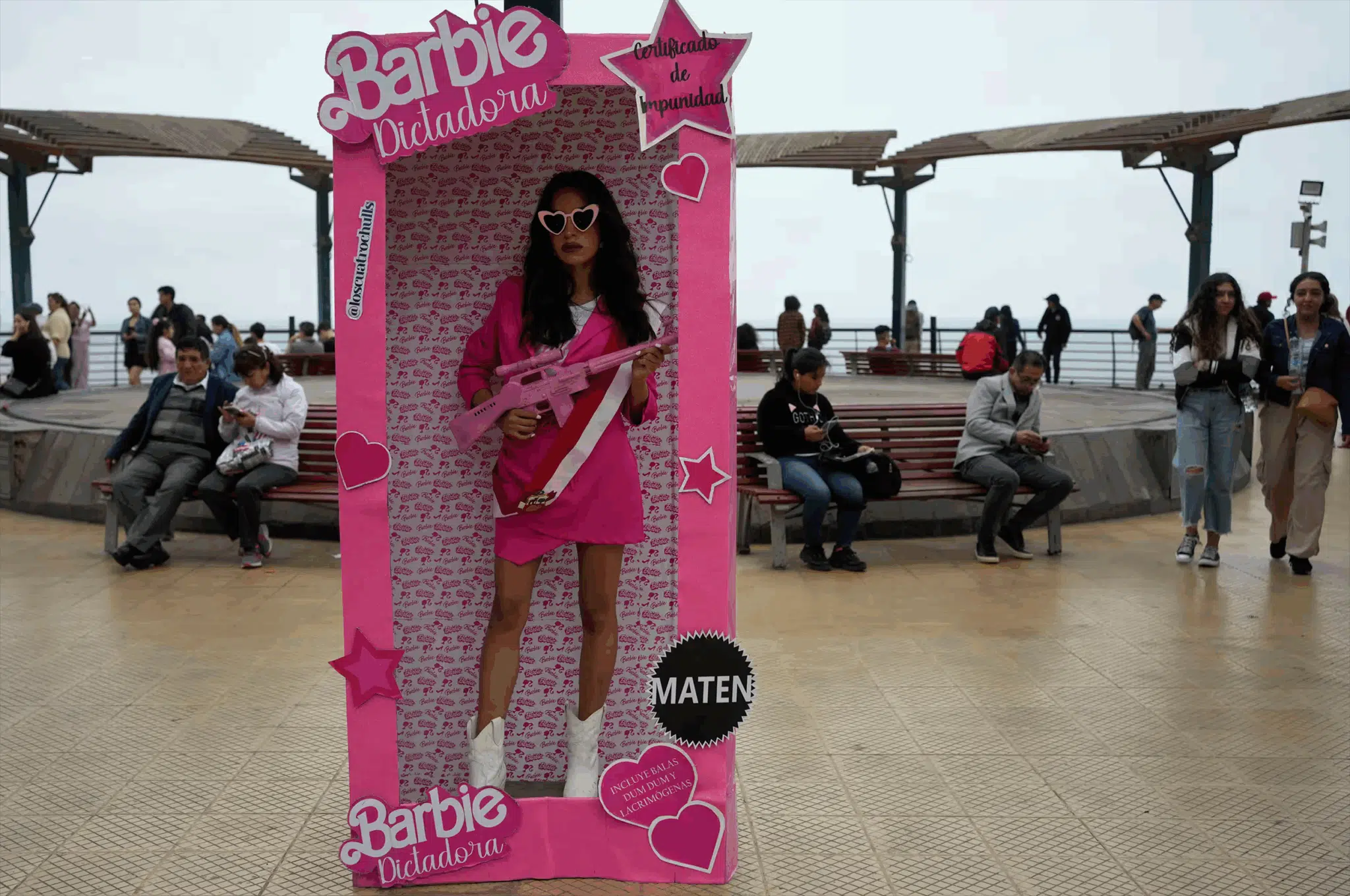
Defining experiential marketing for B2B brands
In the world of B2B, experiential takes place in the form of real-life events (often offline), product demos (often online), or brands can take a hybrid approach using augmented reality (AR) to bring digital experiences into the real world.
While B2B experiential marketing is often less flashy and doesn’t garner quite the virality of B2C marketing, it can help expressive brands stand out within their industry.
Why experiential marketing matters in enterprise marketing
Through memorable brand experiences, experiential marketing deepens customer engagement by connecting brand and prospect more intimately.
Creating differentiation in competitive verticals
In B2B, competitors’ messaging is often similar. Of course, every brand has its USP, but ultimately, you’re solving a problem for your audience. When products are comparable to competitor offerings on paper, everything looks quite the same.
Enter, experiential marketing.
A well-executed, B2B marketing experience showcases your brand and allows you to stand out tangibly and build customer loyalty.
An event organized for your most important audiences is an outward display of your service to them. For example, at MailChimp’s FWD: London event attendees hear from industry leaders and inspiring public figures.
While organizing an event is a service in itself, MailChimp brings its creative and quirky brand to life through its service to event attendees. During Comfort Breaks, attendees can attend product demos, schedule consultations to get them started with MailChimp, and, notably, play MailChimp’s game, FWD.
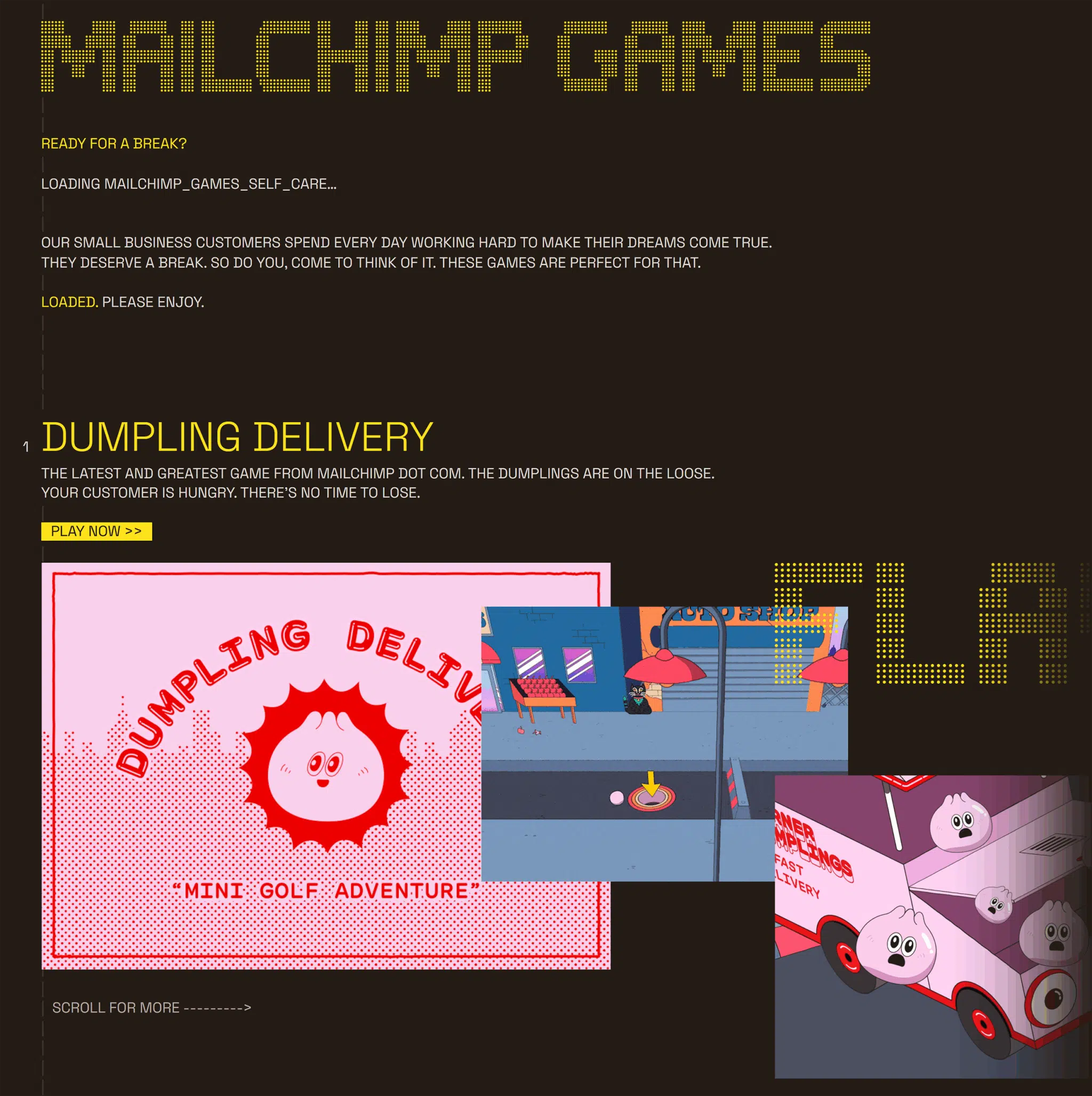
MailChimp has games at its event, and online, as a service to its customers, because, in MailChimp’s words:
“Our small business customers spend every day working hard to make their dreams come true.”
“They deserve a break. So do you, come to think of it. These games are perfect for that.”
Elevating brand trust and credibility
Through product immersion or memorable moments, brands build relationships and trust with prospects. The customer experience is more engaging and often personalized, which helps foster emotional connections more effectively than passive marketing touchpoints like visibility on a social media platform. There can also be an element of word-of-mouth marketing as individuals share their unique experiences.
SmileWorks Grew 24X While Cutting Ad Spend 90% with Semrush Keyword Research
✓ Find high-intent keywords competitors miss
✓ See exactly which terms convert visitors to customers
✓ Discover untapped traffic opportunities specific to your market
Free instant insights.
Supporting long-cycle, multi-stakeholder sales
Memorability is the core of experiential marketing. If your brand stands out creatively or forms an emotional connection with customers, it will remain at the forefront of the decision-making process.
Through experiential marketing, brands create moments worthy of stories, meaning people will talk about them throughout decision-making.
Easy-to-achieve memorability ideas might include arranging for keepsakes, such as a photo strip from a conference photobooth, that help keep your brand alive in your buyer’s mind.
But B2B experiential marketing doesn’t stop there.
Every year, Salesforce’s flagship conference, Dreamforce, causes commotion (the good kind). The event, which takes place in San Francisco, transports attendees to another place. Each year, Salesforce shuts down an entire street, creating a temporary, but immersive, faux national park.

The event has been running since 2003 and is the world’s largest technology event. The map below helps understand the conference’s scale and immersive design, transforming the city streets into woodlands with faux trees and grass. Attendees are known as Trailblazers, apt because those who attend embody the spirit of innovation in their industry. They explore the San Francisco park, a nod to the exploration and boldness required to pioneer an industry.
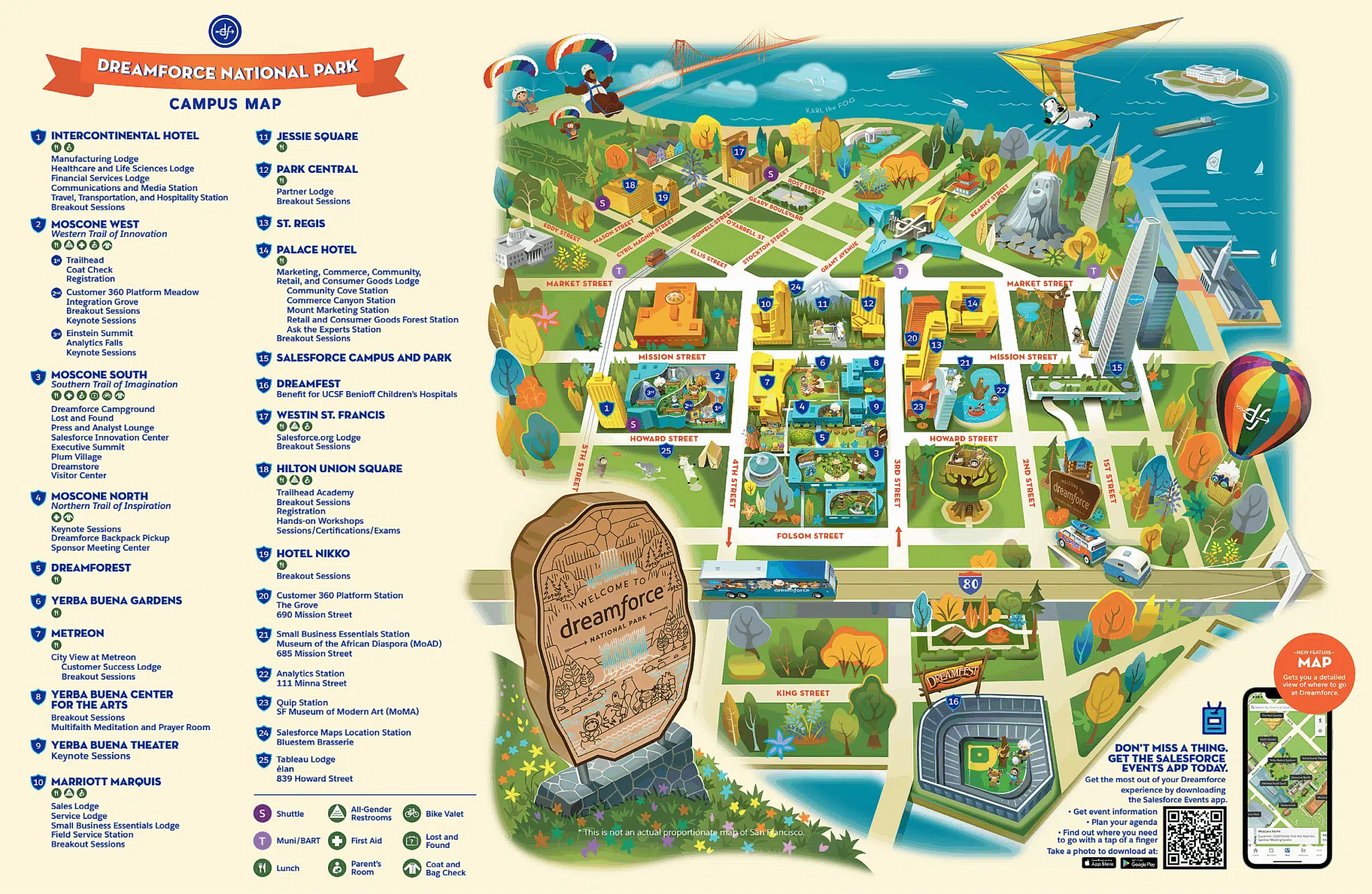
There’s no doubt about it: attending Dreamforce will leave a long-lasting impression, but the benefits of an event like this don’t stop there. Attendees receive opportunities to accelerate their learning with immersive boot camps that quickly get them Salesforce certified. There are also limited-time discounts, like 35% off Salesforce for all attendees.
While momentum is high, Salesforce moves, turning inspiration and energy into action.
Key elements of successful B2B brand experiences
Successful marketing campaigns must align with marketing teams and bring the business as much value as possible. Extra value is especially important for experiential marketing campaigns, which are generally:
- Expensive
- Executed at scale
- Challenging to prove ROI
You must set your campaign up for success, and here are some essential elements:
Strategic alignment with accounts-based marketing (ABM)
There’s no denying it: experiential marketing is expensive, and you have to be strategic about who you target to get the most out of your investment.
This is where account-based marketing comes in.
ABM is about engaging specific, high-value accounts. By aligning and attracting your highest revenue opportunities through experiential marketing, you can maximize marketing efforts to reach potential customers and achieve the best possible ROI.
Pro tip: Consider all customer data when determining the audience most suitable for your experiential marketing campaigns. For example, customers who spend the most initially may not be the highest revenue audiences. Customer lifetime value tells you what audiences spend over time.
Personalization at scale
There is often a personalized element with experiential marketing. For example:
- The offer associated with the event is targeting specific audiences and their particular pain points
- Experiential marketing events might be invite-only
- Immersive experiences such as augmented reality (AR) allow audiences to engage directly with a product or an event. IBM’s AR example below showcases this perfectly.
Engagement across the buying committee
B2B sales processes are rarely linear and nearly always involve multiple decision-makers. Sometimes, products or services are complex, and not all decision makers can fully comprehend the offering.
With immersive experiences, you can create a demo or explainer that engages all decision makers and allows them to explore the product in their own time. If everyone can at least understand the product and its value, the chances of earning buy-in from all decision makers are much higher.
There’s something in this for you, too.
You get real-time, real-world data.
Product demos provide data to sales teams. You might know if prospects logged in, and how many times. Equally, you’ll see if they didn’t log in. While users logging in is a sign of engagement, signing up for a demo, but not logging in, could be more of an opportunity than you’d expect.
ActiveCampaign has been known to book a sales call and set up an email marketing campaign for a prospect who had not logged into their demo account. Perhaps the prospect was overwhelmed or too busy to get started.
The result?
They signed up with ActiveCampaign, of course!
ActiveCampaign went beyond a sales call to provide a much-needed service. It got the prospect rolling with a campaign, and once a customer is using the software, they’re more likely to stay, especially when they know the software serves their needs and the customer service is amazing.
Adequate preparation for sales teams
Naturally, immersive experiences are sales tools for your internal teams. But have you considered the champion within your prospect organization?
In B2B sales, your champion is one person (or maybe a group of people) most invested in your company. Your champion already wants to work with you and is likely persuading their internal teams on your behalf.
With immersive experiences, your champion has a tool designed to persuade and convert.
Give your champion the tools to sell for you.
Immersive experiences provide a tool for breaking down what you do so your champion has the best chance of comprehensively demonstrating your offering.
Pro tip: Spend time with your champion, set up the demo account for success (like ActiveCampaign did), or train the champion as if they were one of your internal sales team members.
Authenticity and value-driven storytelling
Instead of simply telling someone what you do, experiences offer genuine value, education, and interaction between brands and prospects.
Common B2B experiential marketing formats and their benefits
Let’s explore common formats for B2B experiential marketing, including their benefits.
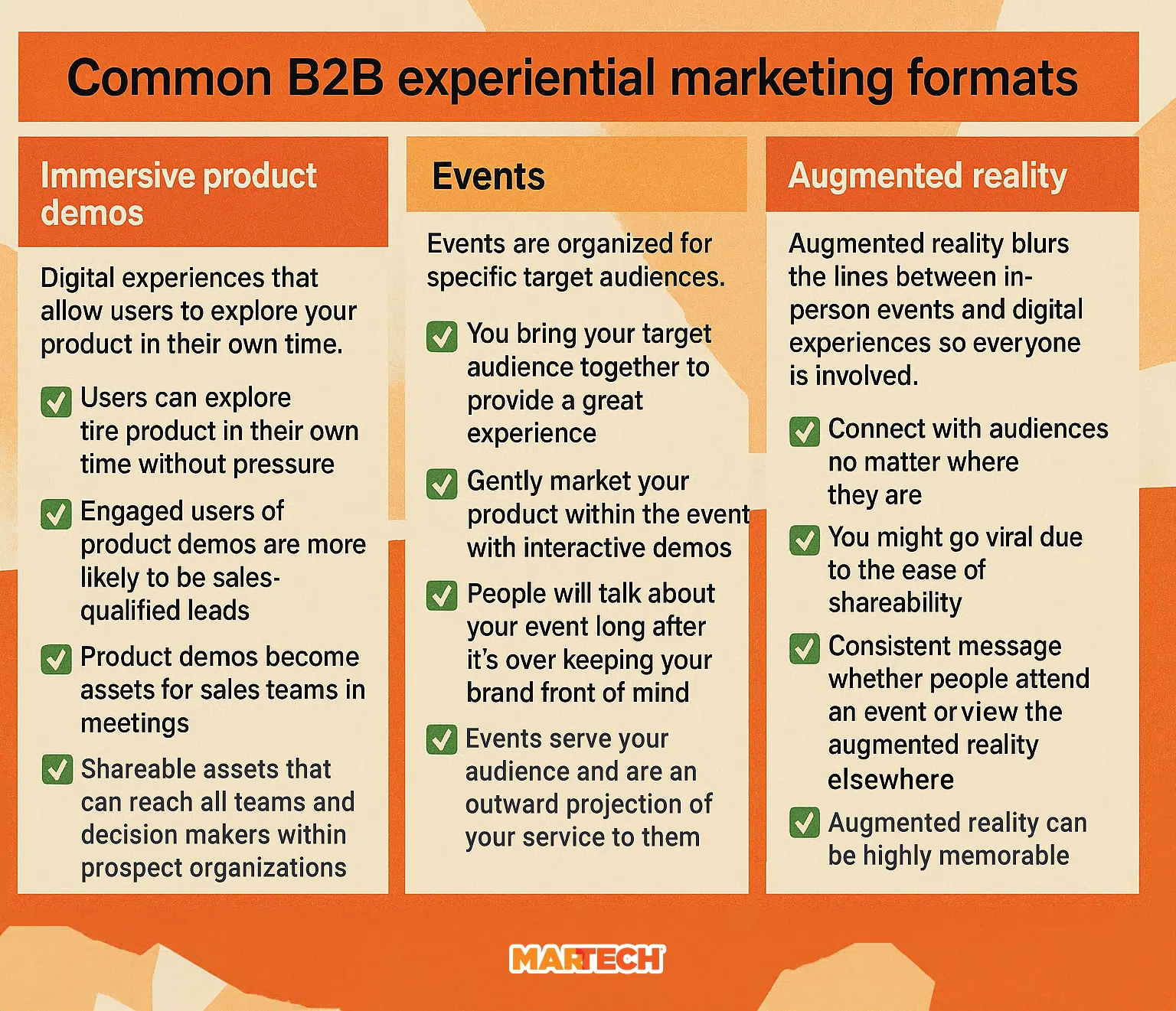
Immersive product demos
Immersive product demos allow brands to showcase their products to audiences who can explore them independently.
Benefits of immersive product demos
- Users can explore the product in their own time without feeling pressure from sales teams.
- Those who have engaged with the demo and requested a call with your sales team or product experts are likely sales-qualified leads (SQLs).
- Product demos can be shared internally, reaching many decision makers and team members. The more team members who like it, the greater the chance of success
- Immersive demos empower internal teams who like your product, giving them the tools to show the product’s full potential.
Events for specific audiences
Events bring your audiences into one room to share an immersive experience, such as a party or conference. If the event meets aspirational levels, it becomes an infamous meeting point where your audiences encounter like-minded people and want to attend for the networking as well as the value the event brings.
Benefits of events for specific audiences
- Your target audience (ideally formed around ABM) is in one room, enjoying themselves at an event associated with your brand.
- People will talk about your event long after it’s over, keeping your brand front of mind.
- It’s an opportunity to show you care about your audience. Instead of just saying it, an event that serves your audience is an outward projection of your service to them.
- You can gently market your product within the event with interactive demos in separate spaces, branded menus, branded charging stations, special drinks, and similar.
Pro tip: Take a subtle approach if your event is more informal, like a party. You want the vibe to be fun and light while marketing your product. Separate spaces for product demos keep the business from those not in that mindset.
Hybrid and virtual experiences using AR
AR is an innovative way to marry virtual experiences with real-life brand experiences. With AR, brands can create immersive experiences that consumers can engage with from anywhere. Plus, where there’s an in-person event, AR can bridge the gap for those who can’t attend.
Benefits of AR for hybrid and virtual experiences
- AR allows you to connect with audiences no matter where they are. If you’re running an event, but people can’t attend, they can still access the most engaging part of your event, a product demo, for example, via AR.
- Greater shareability. Innovative AR can even reach virality with shares on social media.
- It won’t matter how people are discovering your experience, in person or through AR; they will receive a consistent message.
- Highly memorable because these experiences leave a lasting impression.
Starting with AR might seem overwhelming, but it’s easier than you think, particularly with AR and QR code generators. Take a look at AR Code, where you can create an AR and QR code in minutes:

Users can scan the QR code the software generates using their phone camera to put your AR in the real world. The QR code and AR is particularly good for viewing products, or bringing images of items, or logos into the real world. It’s akin to what IBM did with their Think conference (see this example in detail below).

How to measure the ROI of experiential marketing in B2B
With experiential marketing commonly intersecting online and offline events, it can be challenging to measure its ROI.
Challenging, but not impossible.
Next, we’re reviewing ways that you can measure the impact of your experiential marketing, and we’re not forgetting the long-term benefits.
Event engagement and participation metrics
Perhaps one of the most measurable metrics is event engagement or participation. Thanks to registration and ticketing, you’ve tracked how successfully you got your attendees through the door.
But what happens once they’re inside?
You connect real-life and digital experiences to keep actions trackable.
For example, your event likely has an offer attached to it, and your goal is to drive attendees to view and sign up for the offer on a dedicated landing page. To do this, you add QR codes or shortlinks everywhere (flyers, social media, coasters, cups, etc.) to make your offer landing page easy to visit. Make sure your landing page has a URL parameter.
Because URL parameters are trackable, you know how many people clicked the link from the specific event marketing and how many people signed up. AI tools and AI CRMs can quickly and effectively cross-reference your list of signups against the list of attendees to see how impactful the event was at converting attendees.
Important note: If you’re creating real-life events and the marketing directly results in conversions, whether people attended or not, then the event works for your business. To some degree, hype and brand visibility are what you’re looking for with experiential marketing.
Look at the HubSpot experiential marketing example below to see how this tracking method works for them.
Integration with CRM and lead scoring models
Any digitized experience can be fed directly into CRMs to assist with lead scoring metrics by assigning value to leads based on their likelihood of becoming customers. For example, prospects who frequently engage with a demo are more likely to sign up.
If you’re providing digital experiences like demos or engagements with AR, you want to track interactions so you can gauge interest. Over time, AI CRMs can determine how many touchpoints your most engaged prospects have and, therefore, accurately score a lead. The highest-scoring leads should garner the most attention from sales teams.
Influence on deal velocity and pipeline acceleration
Done well, experiential marketing should attract high-value leads and accelerate the sales funnel. Sales teams should be able to see that experiential marketing is moving deals closer to conversion and faster than average.
To measure ROI here, you can track metrics like:
- Average time to close for those who engaged with your experiential marketing versus those that do not
- Re-engagement of cold or stalled deals
- Deals influenced by the event
After an event, sales teams should ask new customers about it. Ask:
- Did you attend the event?
- Was the event influential in your decision to become a customer?
While conversations are not the most measurable or accurate data, this qualitative data can still influence future strategy.
Long-term brand lift and post-event content activation
Your brand engagement is highly measurable, and if an event or immersive experience is as impactful as you’d like it to be, brand mentions and searches should be on the rise.
To gauge measurable interest in your brand, you can look at:
- Branded search traffic before, during, and after the event. You can use Google Search Console for this, and it’s completely free.
- Website visits before, during, and after the event. Use Google Analytics and analyze key pages, such as product pages and pages shared at the event.
- Engagement in marketing, such as emails and social media, will hopefully increase. Review your marketing tools’ analytics before, during, or after an event.
Real-world examples of enterprise experiential marketing
Looking for B2B experiential marketing inspiration? Here are examples from B2B companies that show what it is to be an experience brand.
HubSpot’s events and parties
As part of HubSpot’s culture code, it describes itself as “passionate about serving startups and scaleups.”
With experiential marketing, HubSpot brings its values into tangible real life through events set up to serve its target audience of startups.
A popular example is the Unicorn Oasis party, which unites start-up founders and investors with enjoyable and memorable experiences like BBQs, live local music, and craft drinks.
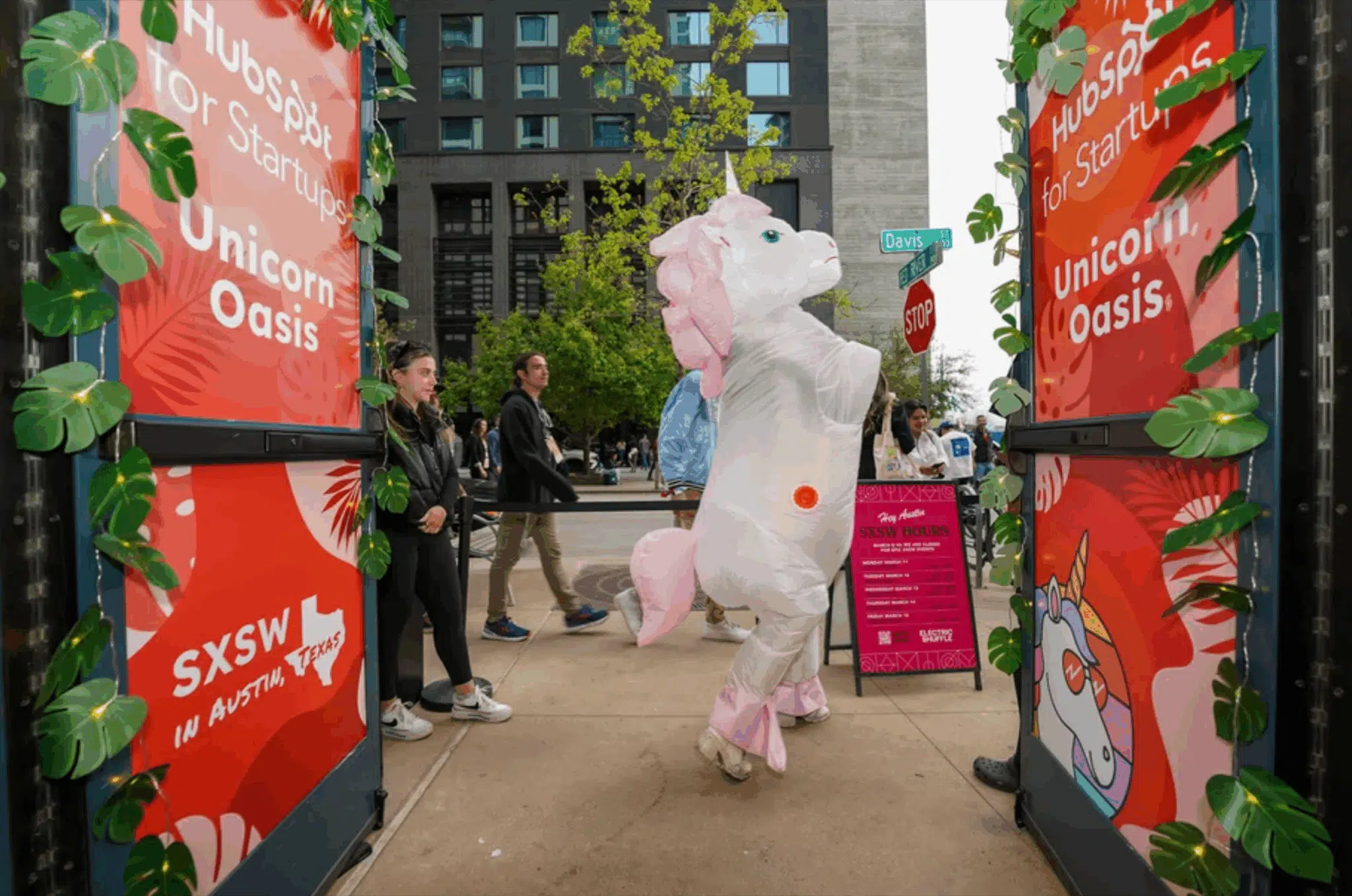
Startups are offered 75% off the HubSpot platform, and these immersive events are designed to leave an impact, keeping HubSpot front of mind long after the event has finished.
HubSpot’s marketing around the Unicorn Oasis party is a perfect example of digital marketing tracking interest from a real-life event. HubSpot uses parameter URLs for links from the Unicorn Oasis party marketing to the “get started with HubSpot” page.
Gong’s virtual interactive demo
While HubSpot’s party is about experiential marketing offline, as Gong demonstrates, immersive experiences are still possible online.
And it’s ideal when you can’t meet your audience face to face.
Gong’s interactive marketing tours walk prospective buyers through their product. Every element is explained with tooltips. Where there are workflows, the demonstration automatically flows like a salesman giving best practice examples.
The interactive demo is comprehensive, but users can still click “help” at the top right of the interface. Plus, a CTA offers a personalized walkthrough with product experts for users ready to take the next step.

This experience allows customers to “self-serve” and experience the product in their own time. Those who are more serious can move down the funnel easily and connect with a product expert.
The interactive demo likely filters out less engaged audiences, bringing the product experts higher-quality leads.
IBM uses AR for consumer engagement and product demos
IBM’s Think Conference showcases products, services, and innovations. Many are new concepts and complex to understand, particularly for decision-makers not involved in the tech.
Immersive AR can break down complex ideas and solutions.
For example, IBM recreated its IBM Quantum System One, the world’s first-ever circuit-based commercial quantum computer, as an AR experience.
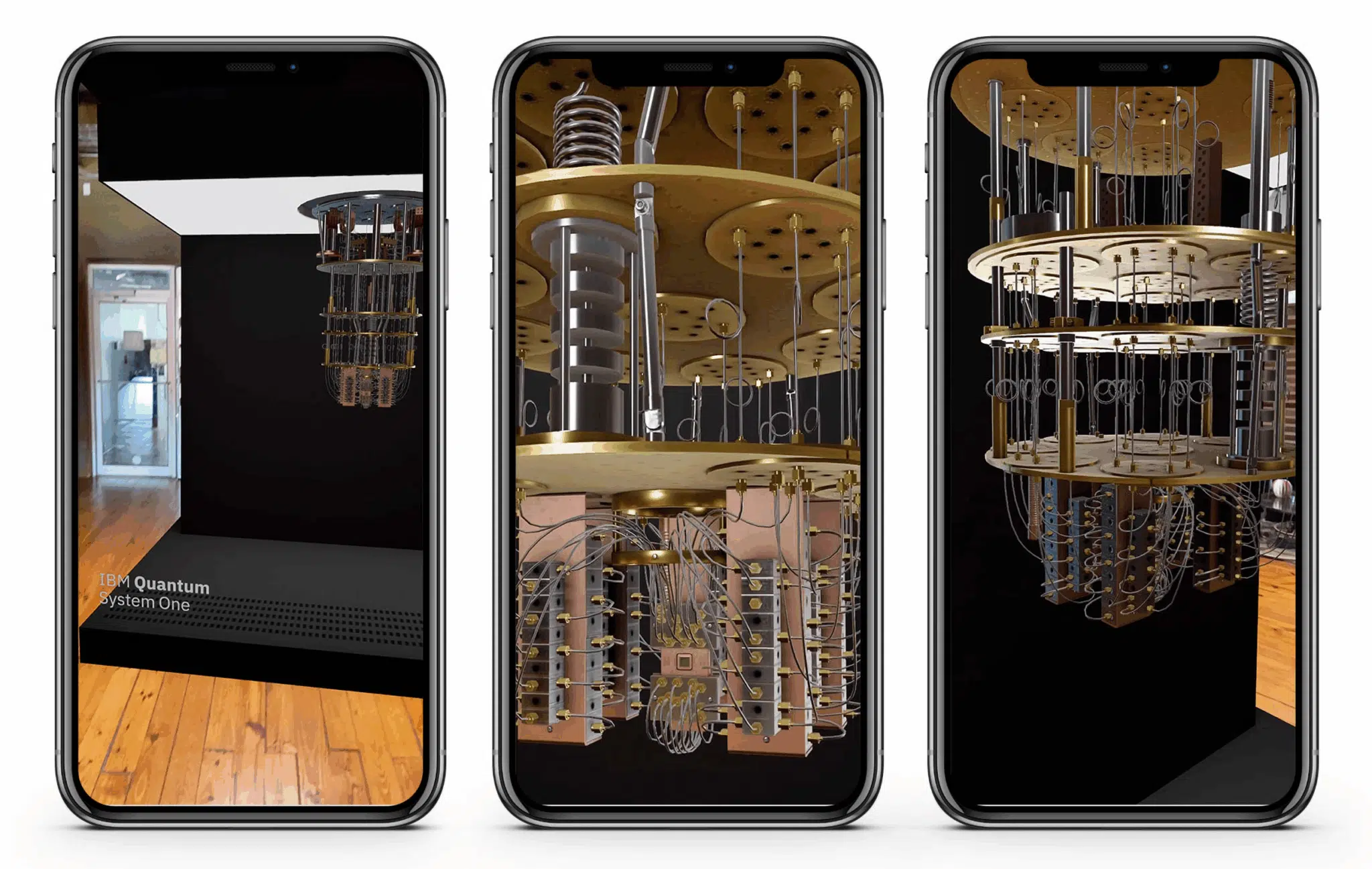
The camera function on mobile phones made the experience even more immersive, putting IBM’s computer “into the room” so you could see its scale.
The experience was promoted on-site at events, but also across digital channels.
IBM combined this digital immersive experience with a memorable keepsake, a THINK “cube” sent to influencers before the event. This cube keeps IBM and its conference front of mind for those who received it.
It’s safe to assume IBM would be selective in who received it: influencers, likely those who could help IBM attract the right audiences.

The physical cube also became part of an augmented reality where audiences could put “think” into the wild. Pictures of this AR were shared across social media, keeping IBM and its conference front of mind.
By tapping into social media, the campaign had a chance of going viral.
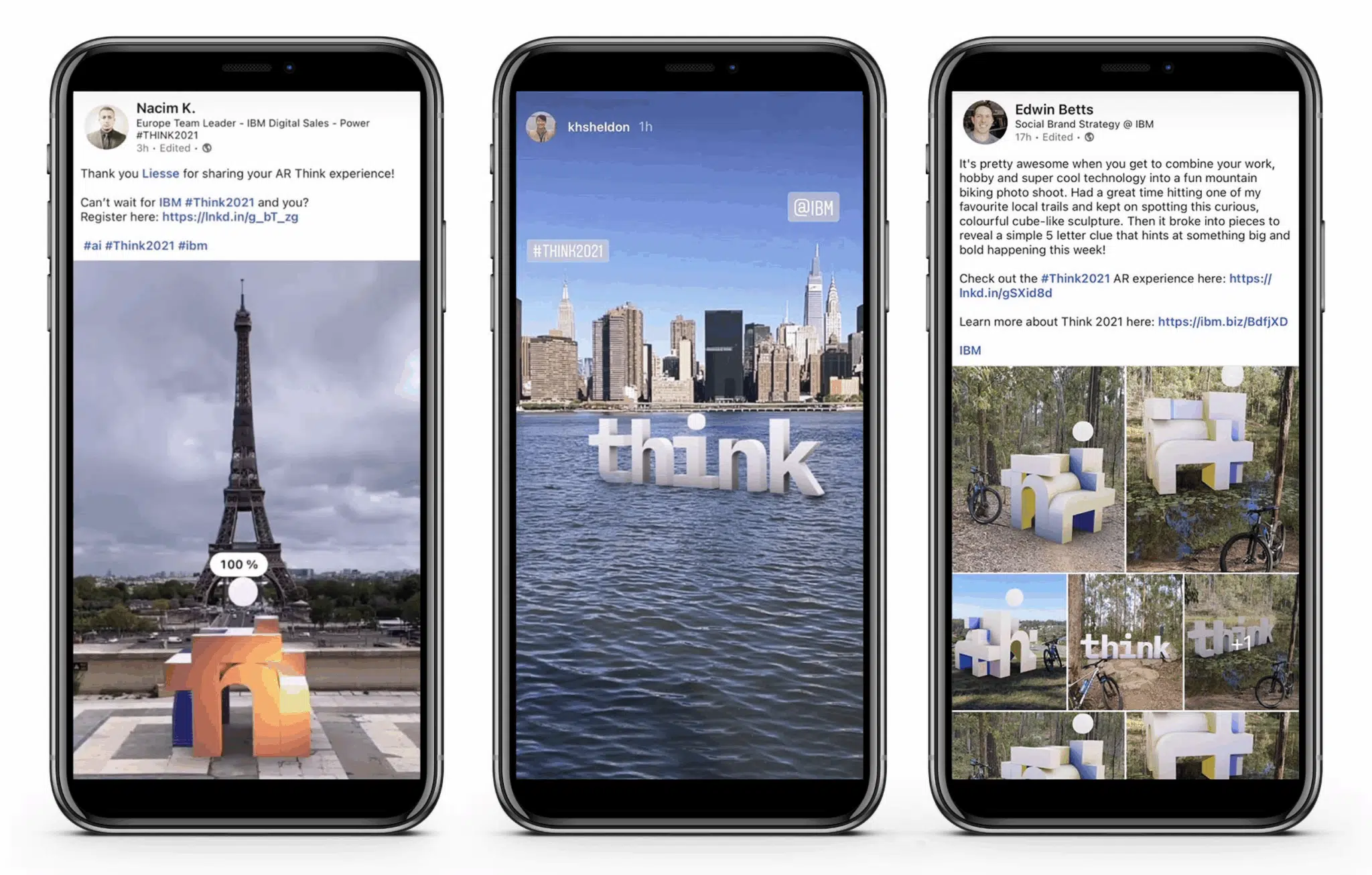
Feeling bold enough for experiential marketing?
It takes a brave and creative business to successfully execute an experiential marketing campaign. Although challenging to track, the benefits can be significant, and the payoff long-term. Especially if your immersive experience provides valuable assets for sales or marketing teams that can be used over and over again.
For more inspiration on creative marketing campaigns, read: How three companies are reinventing event marketing with SoLoMo or Marketers have to play more video games to make better brand experiences.
New on MarTech